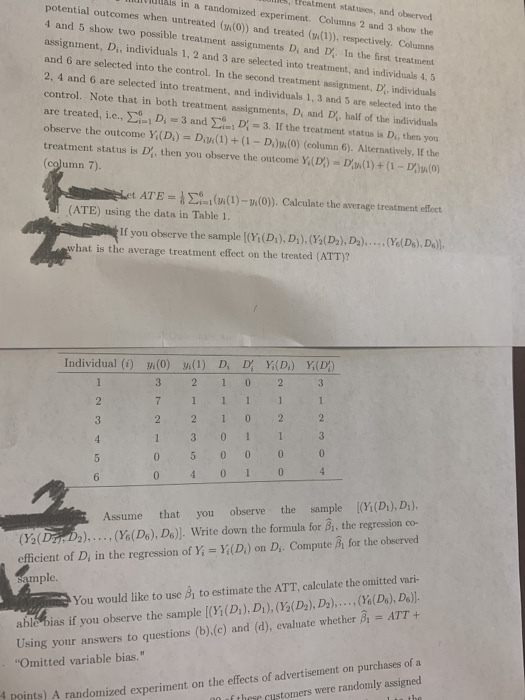
please help to find ATE ATT Bhat 1 and ommitted variable bias.
treatment states, and observed in a randomized experiment. Columns 2 and 3 show the potential outcomes when untreated ((o)) and treated ((1)), respectively. Columns 4 and 5 show two possible treatment assignments Dand D. In the first treatment assignment, D, individuals 1, 2 and 3 are selected into treatment, and individuals 4.5 and 6 are selected into the control. In the second treatment assignment, Dindividuals 2, 4 and 6 are selected into treatment, and individuals 1, 3 and 5 are selected into the control. Note that in both treatment assignments, D and D. half of the individuals are treated, i.e., D. = 3 and D = 3. If the treatment status is D, then you observe the outcome Y (D) = Dix (1) + (1 - D.).(O) (column 6). Alternatively, If the treatment status is then you observe the outcome Y, (D) - D'x (1) + (1 - D)(O) (column 7). ATE=((1) - (0)). Calculate the average treatment effect (ATE) using the data in Table 1. If you observe the sample [(Y(D), D.). (Y:(D), D2).....(Y(De), D.)). what is the average treatment effect on the treated (ATT)? Individual (i) (0) (1) DDY.(D) Y(D) 3 2 0 3 1 2 7 1 1 3 2 2 1 0 2 2 4 3 0 1 3 5 0 5 0 0 0 0 6 0 4 0 1 0 4 Assume that you observe the sample (Yi(D), D), "(Y(D31, D2),...,(Y(D), D.)). Write down the formula for B. the regression co- efficient of D, in the regression of Y; = Y(D) on D. Compute for the observed sample. You would like to use to estimate the ATT, calculate the omitted vari- able bias if you observe the sample [(Yi (D), D.).(Y (D), Du),..., (Yo (De), D.)]. Using your answers to questions (b), (c) and (d), evaluate whether 1 = ATT + "Omitted variable bias." the 4 points) A randomized experiment on the effects of advertisement on purchases of a of the customers were randomly assigned treatment states, and observed in a randomized experiment. Columns 2 and 3 show the potential outcomes when untreated ((o)) and treated ((1)), respectively. Columns 4 and 5 show two possible treatment assignments Dand D. In the first treatment assignment, D, individuals 1, 2 and 3 are selected into treatment, and individuals 4.5 and 6 are selected into the control. In the second treatment assignment, Dindividuals 2, 4 and 6 are selected into treatment, and individuals 1, 3 and 5 are selected into the control. Note that in both treatment assignments, D and D. half of the individuals are treated, i.e., D. = 3 and D = 3. If the treatment status is D, then you observe the outcome Y (D) = Dix (1) + (1 - D.).(O) (column 6). Alternatively, If the treatment status is then you observe the outcome Y, (D) - D'x (1) + (1 - D)(O) (column 7). ATE=((1) - (0)). Calculate the average treatment effect (ATE) using the data in Table 1. If you observe the sample [(Y(D), D.). (Y:(D), D2).....(Y(De), D.)). what is the average treatment effect on the treated (ATT)? Individual (i) (0) (1) DDY.(D) Y(D) 3 2 0 3 1 2 7 1 1 3 2 2 1 0 2 2 4 3 0 1 3 5 0 5 0 0 0 0 6 0 4 0 1 0 4 Assume that you observe the sample (Yi(D), D), "(Y(D31, D2),...,(Y(D), D.)). Write down the formula for B. the regression co- efficient of D, in the regression of Y; = Y(D) on D. Compute for the observed sample. You would like to use to estimate the ATT, calculate the omitted vari- able bias if you observe the sample [(Yi (D), D.).(Y (D), Du),..., (Yo (De), D.)]. Using your answers to questions (b), (c) and (d), evaluate whether 1 = ATT + "Omitted variable bias." the 4 points) A randomized experiment on the effects of advertisement on purchases of a of the customers were randomly assigned
 please help to find ATE ATT Bhat 1 and ommitted variable bias.
please help to find ATE ATT Bhat 1 and ommitted variable bias.





